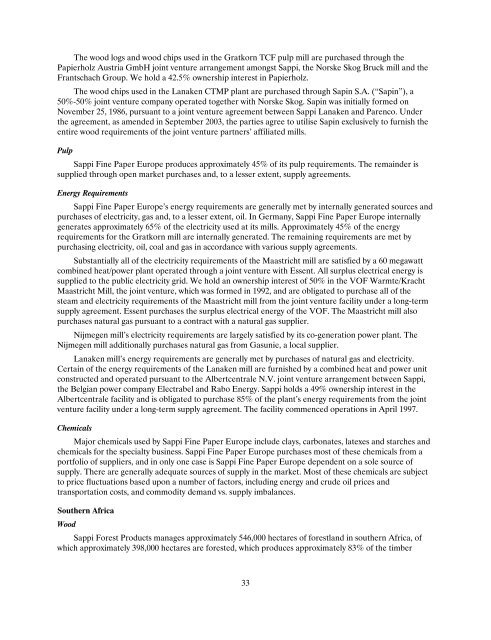You also want an ePaper? Increase the reach of your titles
YUMPU automatically turns print PDFs into web optimized ePapers that Google loves.
The wood logs and wood chips used in the Gratkorn TCF pulp mill are purchased through the<br />
Papierholz Austria GmbH joint venture arrangement amongst <strong>Sappi</strong>, the Norske Skog Bruck mill and the<br />
Frantschach Group. We hold a 42.5% ownership interest in Papierholz.<br />
The wood chips used in the Lanaken CTMP plant are purchased through Sapin S.A. (“Sapin”), a<br />
50%-50% joint venture company operated together with Norske Skog. Sapin was initially formed on<br />
November 25, 1986, pursuant to a joint venture agreement between <strong>Sappi</strong> Lanaken and Parenco. Under<br />
the agreement, as amended in September <strong>20</strong>03, the parties agree to utilise Sapin exclusively to furnish the<br />
entire wood requirements of the joint venture partners’ affiliated mills.<br />
Pulp<br />
<strong>Sappi</strong> Fine Paper Europe produces approximately 45% of its pulp requirements. The remainder is<br />
supplied through open market purchases and, to a lesser extent, supply agreements.<br />
Energy Requirements<br />
<strong>Sappi</strong> Fine Paper Europe’s energy requirements are generally met by internally generated sources and<br />
purchases of electricity, gas and, to a lesser extent, oil. In Germany, <strong>Sappi</strong> Fine Paper Europe internally<br />
generates approximately 65% of the electricity used at its mills. Approximately 45% of the energy<br />
requirements for the Gratkorn mill are internally generated. The remaining requirements are met by<br />
purchasing electricity, oil, coal and gas in accordance with various supply agreements.<br />
Substantially all of the electricity requirements of the Maastricht mill are satisfied by a 60 megawatt<br />
combined heat/power plant operated through a joint venture with Essent. All surplus electrical energy is<br />
supplied to the public electricity grid. We hold an ownership interest of 50% in the VOF Warmte/Kracht<br />
Maastricht Mill, the joint venture, which was formed in 1992, and are obligated to purchase all of the<br />
steam and electricity requirements of the Maastricht mill from the joint venture facility under a long-term<br />
supply agreement. Essent purchases the surplus electrical energy of the VOF. The Maastricht mill also<br />
purchases natural gas pursuant to a contract with a natural gas supplier.<br />
Nijmegen mill’s electricity requirements are largely satisfied by its co-generation power plant. The<br />
Nijmegen mill additionally purchases natural gas from Gasunie, a local supplier.<br />
Lanaken mill’s energy requirements are generally met by purchases of natural gas and electricity.<br />
Certain of the energy requirements of the Lanaken mill are furnished by a combined heat and power unit<br />
constructed and operated pursuant to the Albertcentrale N.V. joint venture arrangement between <strong>Sappi</strong>,<br />
the Belgian power company Electrabel and Rabo Energy. <strong>Sappi</strong> holds a 49% ownership interest in the<br />
Albertcentrale facility and is obligated to purchase 85% of the plant’s energy requirements from the joint<br />
venture facility under a long-term supply agreement. The facility commenced operations in April 1997.<br />
Chemicals<br />
Major chemicals used by <strong>Sappi</strong> Fine Paper Europe include clays, carbonates, latexes and starches and<br />
chemicals for the specialty business. <strong>Sappi</strong> Fine Paper Europe purchases most of these chemicals from a<br />
portfolio of suppliers, and in only one case is <strong>Sappi</strong> Fine Paper Europe dependent on a sole source of<br />
supply. There are generally adequate sources of supply in the market. Most of these chemicals are subject<br />
to price fluctuations based upon a number of factors, including energy and crude oil prices and<br />
transportation costs, and commodity demand vs. supply imbalances.<br />
Southern Africa<br />
Wood<br />
<strong>Sappi</strong> Forest Products manages approximately 546,000 hectares of forestland in southern Africa, of<br />
which approximately 398,000 hectares are forested, which produces approximately 83% of the timber<br />
33
















